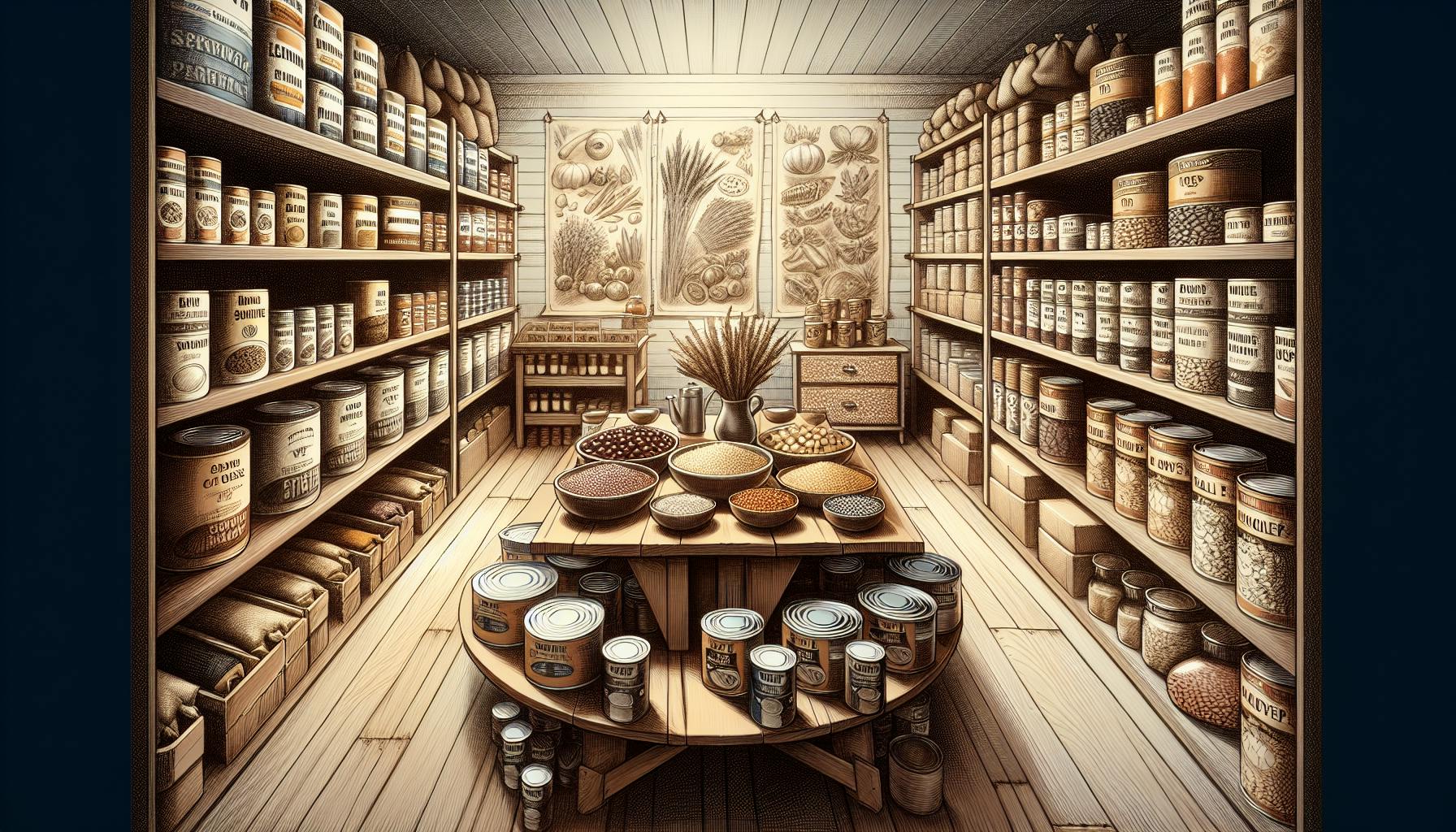When it comes to long term food storage, most will agree that maximizing shelf life is a top priority.
Using high quality mylar bags with proper sealing techniques can dramatically extend the freshness of essential foods for years to come.
In this guide, you'll discover the optimal methods for storing a variety of foods in mylar bags, including choosing the right bags, proper sealing steps, ideal storage conditions, and more for maximizing longevity.
Introduction to Mylar Bags for Food Storage
Mylar bags are a great option for long-term food storage. They create an air-tight barrier that blocks moisture and oxygen from getting in, which prevents spoilage. This allows you to safely store food for years.
Benefits of Using Mylar Bags
- Creates air-tight seal to block moisture and oxygen
- Durable and reusable
- Enables long-term storage up to 10-15 years
- Comes in various convenient sizes like large mylar bags for bulk items
- Cost-effective for stockpiling food storage
Choosing the Best Mylar Bags
When selecting mylar bags, opt for thicker, high-quality bags to prevent tears or punctures over time. Consider the appropriate size bag for your needs - large mylar bags work well for bulk pantry staples like rice, beans, and grains. Smaller pouches are great for single-serving portions.
Best Foods for Long Term Storage
Many foods store remarkably well in mylar bags for 10-15 years. Some of the best options include:
- Rice, beans, pasta, oats
- Dehydrated fruits and vegetables
- Freeze-dried meats
- Granola and cereals
- Nuts and trail mixes
Proper Sealing Techniques
Creating an air-tight closure is crucial to preserving freshness. Invest in a quality heat sealer and apply constant pressure across the entire bag opening to effectively bond the plastic layers together. Allow bags to fully cool before handling or stacking to prevent accidental openings.
Optimizing Storage Conditions
Keep stored mylar bags in a cool, dark place like a basement or cellar. Avoid placing bags directly on bare floors or concrete to prevent moisture damage over time. For larger quantities, use Mylar bags for food storage 5 gallon size or larger. With proper storage methods, your food can remain fresh for over a decade.
How long can food be stored in a Mylar bag?
Some foods can last as long as twenty-five years using Mylar bags, but we don't suggest storing food for more than five years. While Mylar bags create an oxygen-free environment that inhibits bacteria growth and oxidation, the quality and nutritional value of food still slowly declines over time.
Here are some guidelines on maximum recommended storage times for foods in Mylar bags:
- White rice, white flour: up to 25 years
- Grains, pasta: 5 years
- Dried beans, peas: 5 years
- Freeze dried foods: 5 years
- Powdered milk: 5 years
- Oats: 4 years
- Instant/cooked foods: 2 years
When sealing mylar bags, make sure to use an iron to create a complete moisture and oxygen barrier. Properly storing bags by keeping them in cool, dark places will also help maximize shelf life. Track storage and expiration dates and routinely check for signs of spoilage.
For long term food storage success, mylar bags in 5 gallon sizes work best to contain large volumes. By considering these shelf life factors and proper storage methods, your essentials can last for years in mylar bags when needed.
What can you not put in Mylar bags?
When using mylar bags for food storage, it's important to understand what types of foods should not be stored in them. Mylar bags create an oxygen-free environment that helps preserve dry goods, but they are not suitable for foods with higher moisture content.
Here are some examples of foods you should avoid putting in mylar bags:
-
Fresh fruits and vegetables - The moisture causes rapid spoilage without proper airflow.
-
Meat and dairy products - These are highly perishable and require refrigeration. Bacteria grows quickly without oxygen.
-
Baked goods and pastries - Similar to produce, these get moldy without airflow to control moisture.
-
Canned goods - The metal cans are air-tight already, so mylar bags are unnecessary.
The danger with incorrectly packaging moist foods in oxygen-free environments is the risk of botulism and other harmful bacteria. Without proper drying and sealing, the moist food will spoil and grow anaerobic bacteria.
The safe rule of thumb is only foods with 10% moisture content or less should go in mylar bags. This includes grains, rice, pasta, dried beans, flour, sugar, salt, coffee, spices, etc. Be sure to include an oxygen absorber in each bag to remove remaining oxygen.
With the right dry foods and packaging technique, mylar bags can effectively extend shelf life for years. But anything moist is unsafe for long term storage. Stick to very dry goods only.
What foods are best in Mylar bags?
The best foods to store in mylar bags for food storage are those that are dry and have very little moisture content. Good options include:
-
Dried fruits and vegetables like raisins, dried apricots, dehydrated carrots, etc. Dehydrating foods removes moisture, allowing them to be stored long-term.
-
Grains like rice, pasta, oats, barley, wheat berries, etc. Grains have a long shelf life when properly stored.
-
Beans and legumes like lentils, split peas, black beans, pinto beans, etc. Simply keep them dry.
-
Powdered milk and powdered eggs. By removing the moisture, these dairy products gain extended shelf lives.
-
Spices and seasonings like salt, pepper, garlic powder, cinnamon, etc. Spices in ground form store well in mylar with oxygen absorbers.
-
White sugar and other dry sweeteners like brown sugar, honey powder, maple sugar, etc. These tend to store well when moisture sealed out.
-
Flour and other baking ingredients like baking soda, baking powder, yeast, etc. As long as you prevent moisture, these items will last.
The key is ensuring the food is completely dry before sealing in mylar bags. Oxygen absorbers can also be added to help remove remaining oxygen and extend shelf life even further. By focusing on low-moisture foods, mylar bags for food storage can keep foods fresh for years.
sbb-itb-b932644
How thick do Mylar bags need to be for long-term storage?
When it comes to long-term food storage, the thickness of the mylar bag is crucial for maintaining freshness and preventing spoilage. The ideal mylar thickness for long-term storage is 5 to 7.5 mils.
Bags less than 4.5 mils are not recommended for long-term storage for a few key reasons:
- They provide less protection from oxygen and moisture
- They don't properly insulate foods from temperature fluctuations
- They can easily rip under the weight of stored foods
Thicker mylar between 5-7.5 mils has superior:
- Oxygen and moisture barriers to prevent spoilage
- Insulation to maintain cool temperatures
- Durability to avoid rips even when holding heavy items
So when preparing your emergency food supply or any goods for long-term needs, be sure to use mylar bags that are at least 5 mils thick for the best chance of long-lasting freshness over many years of storage. The minor additional cost is well worth it for the vastly extended shelf life.
How to Fill and Seal Large Mylar Bags for Food Storage
Properly filling and sealing large mylar bags for food storage helps block oxygen and moisture to extend shelf life for bulk items.
Remove Excess Air from Large Bags
Gently press out air while filling large mylar bags for food storage, then smooth remaining air toward the open end prior to sealing. This removes oxygen that can degrade food quality over time. For best results, use a vacuum sealer if available to remove the most air possible.
Use Oxygen Absorbers in 5 Gallon Mylar Bags
For mylar bags for food storage 5 gallon size, add an appropriate oxygen absorber to remove oxygen from inside the bag to further extend shelf life for large quantities of food. Follow package directions to activate oxygen absorbers before placing in the bag.
Seal Bags with a Quality Heat Sealer
Run heat sealer over the entire bag opening of large mylar bags, applying firm pressure to create an air-tight closure. This prevents air and moisture from entering the bag, helping to maximize shelf life. Be sure to use a heat sealer designed for mylar bag sealing.
Test Seal Integrity After Cooling
After the bags cool, gently squeeze to check for air leaks which indicate an incomplete seal, especially important for large mylar bags for food storage. If leaks are found, re-seal the bag. Proper seals are vital to prevent air exposure.
Date and Label Sealed Bags
Mark large mylar bags with contents, date sealed, and best-by date to aid organization and retrieval. Proper labeling allows for easy identification of shelf life for rotation purposes. Place labels on the sealed edge for readability.
Recommended Foods for Mylar Bag Storage
Certain foods store exceptionally well long-term in mylar bags when properly sealed, including:
Rice and Grains
White rice, beans, lentils, rolled oats have a shelf life of 10-15 years in mylar with oxygen absorbers. This is because the low moisture content prevents bacteria and mold growth. Mylar blocks light exposure to prevent degradation of nutrients. An oxygen absorber removes oxygen from the bag, inhibiting oxidation.
For best results, store white rice varieties like jasmine and basmati over brown rice, which contains natural oils that can still spoil over time. Before sealing, do a visual check to ensure grains are fully dry with no signs of moisture or clumping. Store smaller 1-2 pound bags to limit air exposure when opening.
Pasta and Dry Goods
Pasta, bouillon cubes, baking soda, powdered milk can last 8-10 years stored in mylar bags. The dry environment preserves these goods by preventing moisture and oxygen from enabling bacterial growth. Pasta's simple ingredients of semolina flour and water have an indefinite shelf life when kept dry.
Opt for sturdier pasta shapes like penne, rotini or farfalle over delicate angel hair which can be crushed. Consider adding a desiccant pack along with an oxygen absorber to maintain zero moisture. Either wrap or separate flavored bouillon cubes from other foods to prevent scent transfer.
Dehydrated Fruits and Vegetables
Dehydrated produce like apples, carrots, onions are ideal for mylar, lasting 10+ years. The dehydration process removes moisture to inhibit microbial growth. Mylar bags provide an additional barrier against rehydration and oxygen intrusion.
Dehydrate thin slices or dices of fruit and vegetables until completely brittle and dry to the touch. Allow to cool fully before sealing in bags, as trapped moisture can breed bacteria. Inspect for visible moisture or condensation before sealing. Combining produce with oxygen absorbers ensures maximum freshness.
Nuts, Seeds, and Nut Butters
Nuts in shells, seeds, nut butters sealed in mylar bags have a 5-8 year shelf life. The high oil content of nuts and seeds means storage conditions must be optimized for freshness. Mylar prevents oxygen and light from causing nut oils to go rancid.
For best results, store unshelled nuts like almonds and walnuts rather than shelled. The shells protect the oils from degrading. Consider freezing nuts and nut butters for 72 hours before bagging to kill any insect eggs. Always use oxygen absorbers to remove oxygen.
Hard Candy and Chocolates
Keep treats like peppermints, chocolate bars, and wrappers fresh for 2-5 years in mylar bags. The airtight bags prevent moisture from compromising texture and prevent oxygen from causing oxidation.
Store high cocoa content dark chocolate over milk for maximum preservation. Wrap each candy bar separately before sealing to avoid adhesion. Consider adding desiccant packs to absorb any trapped moisture within wrappers. Allow bars to fully solidify after tempering before bagging.
Tips for Maximizing Shelf Life with Mylar Bags
Proper storage and sealing are key to getting the most out of your mylar bags for food storage. By following best practices when using mylar bags for food storage, you can extend shelf life dramatically compared to traditional storage methods.
Invest in the Best Mylar Bags for Longevity
When selecting mylar bags for long term food storage, premium thicker bags with durable construction will preserve foods much better than cheaper versions. The 7+ mil thick bags resist punctures, preventing excess oxygen from compromising food freshness over many years. This allows long term storage of essentials in the pantry.
Double Wrap Vulnerable Foods in Large Mylar Bags
For foods with sharp edges or delicate items stored in extra large mylar bags, add a secondary plastic bag liner inside the mylar as supplemental protection. This helps prevent accidental rips or holes inside the bag when placing bulky items inside initially or retrieving them later on. Useful for large mylar bags for food storage holding greater than 5 gallons.
Store Sealed Bags in Optimal Conditions
To get the most mileage out of your mylar bag sealed food supply, store them properly for maximum longevity. Keep bags in cool, dark spaces away from direct light and heat. Periodically check bags for any seal breaches allowing air inside over time, especially for the 5 gallon mylar bags holding more substantial bulk quantities.
Maintain Inventory and Organization
With large volumes of foods sealed away in mylar bags, keep a master list notating bag contents, seal date, and best-by timeframe. This allows easy reference for meal planning or identifying what needs to be consumed first before it expires. Particularly useful when dealing with giant mylar bags stored in deep pantries holding vast quantities of preserved foods.
Practice First In, First Out
When taking stored foods out for meals, follow first in, first out practices - consume the oldest sealed bags first to maximize overall shelf life of inventory. Make note during inventory checks of any bags nearing expiration to prioritize their use, especially important for the extra large mylar bags that tend to hold more substantial food volumes.
Final Thoughts on Preserving Food with Mylar Bags
Mylar bags are a useful tool for long-term food storage success. When properly sealed, they block oxygen and moisture to extend the shelf life of stored foods for years. Here are some final tips for getting the most out of mylar bags:
Use Quality Bags and Proper Sealing Techniques
Invest in thick, high-quality mylar bags to prevent tears or leaks. Be sure to seal them completely using an iron or impulse sealer for an airtight closure. This keeps oxygen from entering and degrading food quality over time.
Organize and Label Your Bags
Clearly label each bag with the contents and date sealed. Store similar items together and keep an inventory to easily identify what needs to be used first from storage. This organization will ensure you rotate stock and use food before it expires.
Store Bags Properly
Keep mylar bags in a cool, dark place like a basement or cupboard. Monitor storage conditions closely to prevent temperature fluctuations that could compromise the seal. Position bags off the floor to prevent water damage or pest access.
With proper usage, mylar bag food storage lets you safely stockpile essentials for years to come. Use suitable bag sizes for your needs, like 5-gallon bags for bulk ingredients. This will ensure you have long-lasting emergency reserves when needed.


